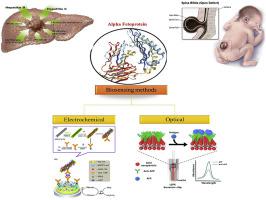Trends in Analytical Chemistry ( IF 11.8 ) Pub Date : 2020-06-30 , DOI: 10.1016/j.trac.2020.115961 Arash Mohammadinejad , Reza Kazemi Oskuee , Reza Eivazzadeh-Keihan , Majid Rezayi , Behzad Baradaran , Ali Maleki , Mahmoud Hashemzaei , Ahad Mokhtarzadeh , Miguel de la Guardia

|
Alpha-fetoprotein as a multifunctional glycoprotein with a dual regulatory role in cancer and fetal activities is belonging to an albuminoid gene family. Due to important biological activities of alpha-fetoprotein in the adjustment of cancer, the level of this biomarker, majorly in liver carcinomas, abnormally is elevated. Also, the probability of high-risk or low-risk patients for chromosomal abnormalities can be identified by the serum level of alpha-fetoprotein. The detection of biomarkers possesses an important role in prognosis and early diagnosis of cancer and other diseases. So, the development of accurate and sensitive methods for measurement of alpha-fetoprotein is of great importance. Among the various methods which have been developed to detect biomarkers, biosensors present promising role due to advantages of high sensitivity specificity, easy operation, and instrumentation. Hence, the present review focuses on the studies in the field of designing and fabrication of optical and electrochemical biosensors for the identification and quantification of alpha-fetoprotein. This review obviously indicates that designed and introduced biosensors have been well fabricated through surface modification, nanofabrication, and bio-functionalization techniques to detect alpha-fetoprotein below the cut-off level (20 ng/mL). Despite various advantages of established biosensors, but they still suffer from some defects to develop in clinical assays. The optical biosensors possessed more complex designing in comparison with electrochemical biosensors, which limits their application for clinical goals. Also, it is highly demanded to the incorporation of sensitive and easy to structure of electrochemical biosensors with microfluidic chips to enable high-throughput sample detection, portability, point-of-care and post-operative usage in the future researches.
中文翻译:

用于检测甲胎蛋白的生物传感器的开发:作为肝细胞癌的主要生物标志物
甲胎蛋白是在癌症和胎儿活动中具有双重调节作用的多功能糖蛋白,属于白蛋白基因家族。由于甲胎蛋白在调节癌症中具有重要的生物学活性,因此该生物标志物的水平(主要在肝癌中)异常升高。同样,可以通过甲胎蛋白的血清水平来确定高危或低危患者发生染色体异常的可能性。生物标志物的检测在癌症和其他疾病的预后和早期诊断中具有重要作用。因此,开发准确,灵敏的α-甲胎蛋白检测方法非常重要。在检测生物标志物的各种方法中,生物传感器由于具有高灵敏度特异性,易于操作和仪器化的优势,因此具有广阔的前景。因此,本综述着重于光学和电化学生物传感器的设计和制造领域的研究,以鉴定和定量甲胎蛋白。该评论显然表明,已设计和引入的生物传感器已经通过表面修饰,纳米制造和生物功能化技术进行了很好的制造,以检测低于临界水平(20 ng / mL)的甲胎蛋白。尽管已建立的生物传感器具有多种优势,但它们仍存在一些缺陷,需要在临床检测中发展。与电化学生物传感器相比,光学生物传感器具有更复杂的设计,这限制了其在临床目标中的应用。也,











































 京公网安备 11010802027423号
京公网安备 11010802027423号